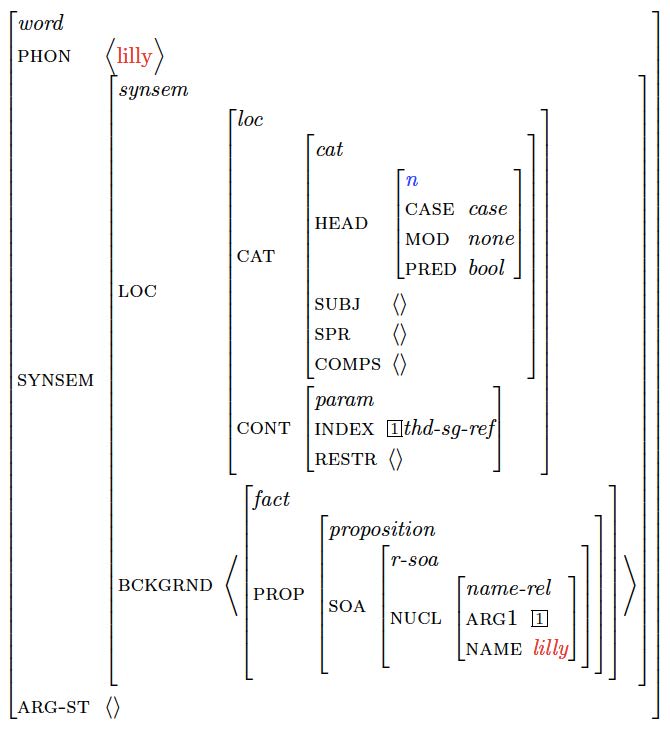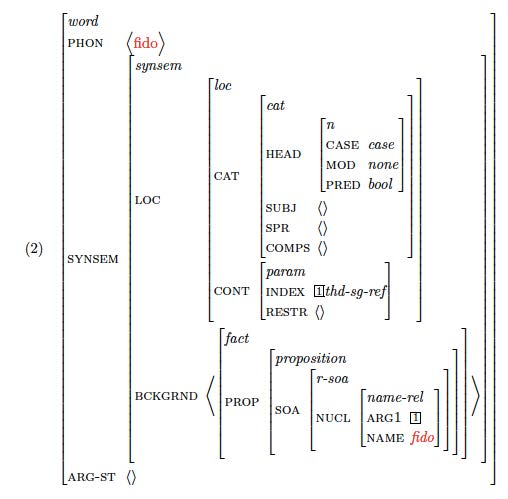HPSG: Difference between revisions
(→Words) |
(→Words) |
||
| Line 51: | Line 51: | ||
which means that they must combine with a determiner like ''a'' or ''the'' in order to function as a subject or an object. | which means that they must combine with a determiner like ''a'' or ''the'' in order to function as a subject or an object. | ||
With this background about the 3 valence attributes, look at the lexical entries for ''Lilly'' and ''Fido'' again. You see that both expressions are marked as | |||
SUBJ <> | |||
SPR <> | |||
COMPS <>. | |||
From this we conclude that both words do not need to be combined with a subject, a specifier, or any complements in order to function as the subject or object of a sentence. And this is correct, as the two sentences below illustrate: | |||
(1) <span style="color: blue>Lilly snores.</span> | |||
(2) <span style="color: blue>I like Fido.</span> | |||
In (1), the word ''Lilly'' serves as the subject of the verb ''snores'' and can do so all by itself. In (2), the word ''Fido'' is the direct object complement of the transitive verb ''likes'' and again it can do so all by itself. Compare this with what happens, when we substitute a common noun for the names ''Lilly'' and ''Fido'' in the sentences above: | |||
(3) <span style="color: blue>*Student snores.</span> | |||
(4) <span style="color: blue>*I like cat.</span> | |||
Both sentences become ungrammatical! The reason is simple: as already mentioned above, common nouns like ''student'' or ''cat'' are [SPR <D>], which means that they first need to combine with a determiner in order to serve as the subject or object of a sentence. Thus, (3) and (4) can be made grammatical by putting determiners in front of the two common nouns: | |||
(5) <span style="color: blue>'''The''' student snores.</span> | |||
(6) <span style="color: blue>I like '''any''' cat.</span> | |||
Revision as of 13:11, 15 April 2017
From a syntactic point of view, the smallest constituents (= pieces) of sentences are words. So, it is natural that our syntactic journey begins with words. If you think about it, you need to know a lot about a word in order to use it grammatically:
- its pronunciation
- its part of speech
- its valence, i.e. the number and type of subjects and objects it combines with
- its meaning
- and perhaps its inflection (things like case, tense, and agreement).
If a formal, i.e. precise grammar is supposed to model what speakers who use the grammar know about their language, then the grammar will have to precisely represent all the information in the list above as well. So, let us look at how Head-Driven Phrase Structure Grammar represents lexical information (= information about words). We will see that similar words have very similar lexical entries.
Words
Let us look at a fairly simple class of words, namely names:
We put two words next to each other, the word Lilly on the left and the word Fido on the right:
That looks like a lot of information, but recall that in the previous section we recognized that speakers know much about the words of their language!
So, let us go through the list we made earlier and see where and how each type of information is contained in the structures above. Since both words are names, we would expect the two representations to have something in common; but since they are different names, we would also expect them not to be completely identical.
In the top left of both representations, the word word captures the fact that Lilly and Fido are both words, rather than phrases or sentences. Let's now go through the list of word properties that we collected above
We begin with the first item on the list: speakers know the pronunciation of the words of their language. Is this information contained in the two representations above and if so, where? You will probably have spotted the attribute PHON in both words. On the left it takes the value <Lilly>, whereas on the right it takes the value <Fido>. This is how we represent that the words Lilly and Fido have the pronunciations that they do. At this point, you should protest and say that in-between the angled brackets we have just written the letters that make up the spelling of these words rather than the phonological segment that make up their pronunciation! Congratulations: you would be absolutely right!!! In fact, you have noticed a trick that syntacticians use all over the world when dealing with phonology. When it doesn't hurt, i.e. when we are really dealing with syntactic issues that are not influenced by the phonological properties of words, phrases, and sentences, then we simplify our lives by substituting the spelling of words for the representation of their phonological segments in terms of the International Phonetic Alphabet. If you promise to keep the secret, then you are allowed to use this trick as well, but only as long as you do syntax!
Returning to our two words above, we have already found 3 things that they have in common and one where they differ: (i) both are marked as word, (ii) both have a PHON attribute, expressing that they have a phonology, and (iii) in both cases the value of this attribute is a list of "segments", in truth letters. The difference that we found is that the PHON value is <Lilly> in one case and <Fido> in the other.
The second piece of information in our list of properties that speakers know about the words in their language is their part of speech. Traditional grammar categorizes both words as nouns. In our formal theory this is represented as the blue n at the end of the path SYNSEM|LOC|CAT|HEAD. Do not worry for now about the meanings of the elements in the path, those will be explained in due course!
Next on our list comes valence, i.e. the representation of the knowledge speakers have about what other kinds of constituents the word needs to combine with. You will remember from traditional grammar the distinction between intransitive and transitive verbs. These are just names for those verbs, respectively, which do not need a direct object (i.e. the verbs appear and cough) and those which do (like have and trust). Objects are called complements in our theory; so, to express that the verb have needs a direct object, its representation would contain the line
COMPS <NP>,
which translated into people speech means that the expression needs one and only one complement and that the part of speech of this complement needs to be NP.
Correspondingly,
COMPS <>
means that the expression does not need and, in fact, is not allowed to combine with any complement. That is correct for intransitive verbs like appear, since you cannot say such things as *Lilly appears the cake..
As we will see, words cannot only select complements, but also subjects and specifiers. This is what the two attributes SUBJ and SPR are for. When we get to verbs, we will see that they are marked as
SUBJ <NP>,
i.e. they must have a subject NP and so-called common nouns (i.e. cat or student) are listed as
SPR <D>,
which means that they must combine with a determiner like a or the in order to function as a subject or an object.
With this background about the 3 valence attributes, look at the lexical entries for Lilly and Fido again. You see that both expressions are marked as
SUBJ <> SPR <> COMPS <>.
From this we conclude that both words do not need to be combined with a subject, a specifier, or any complements in order to function as the subject or object of a sentence. And this is correct, as the two sentences below illustrate:
(1) Lilly snores. (2) I like Fido.
In (1), the word Lilly serves as the subject of the verb snores and can do so all by itself. In (2), the word Fido is the direct object complement of the transitive verb likes and again it can do so all by itself. Compare this with what happens, when we substitute a common noun for the names Lilly and Fido in the sentences above:
(3) *Student snores. (4) *I like cat.
Both sentences become ungrammatical! The reason is simple: as already mentioned above, common nouns like student or cat are [SPR <D>], which means that they first need to combine with a determiner in order to serve as the subject or object of a sentence. Thus, (3) and (4) can be made grammatical by putting determiners in front of the two common nouns:
(5) The student snores. (6) I like any cat.

